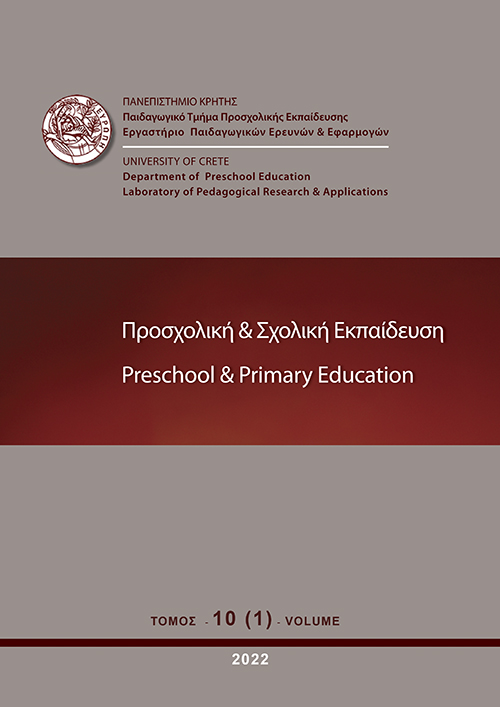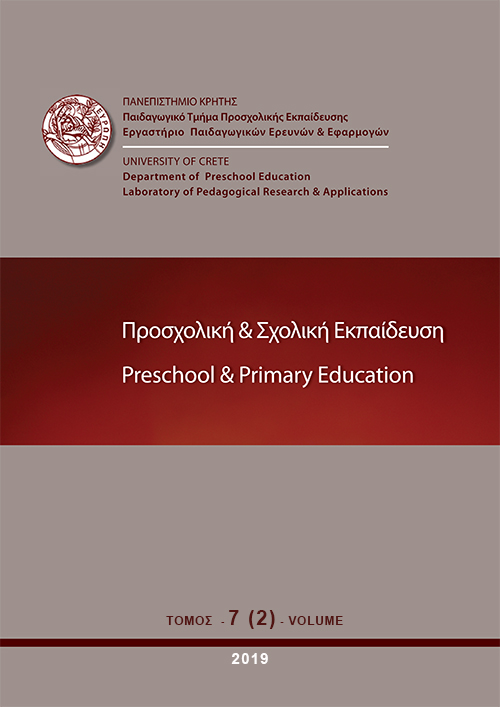Καλλιέργεια της δημιουργικότητας μαθητών Δημοτικού μέσω στοχευμένων δραστηριοτήτων εντός του Αναλυτικού Προγράμματος

Аннотация
Η παρούσα έρευνα εστιάζει στη μελέτη των αντιλήψεων των εκπαιδευτικών και των μαθητών αναφορικά με τη δημιουργικότητα των τελευταίων, καθώς και στην καλλιέργεια της δημιουργικότητας μαθητών Ε΄ και Στ΄ τάξης Δημοτικού μέσα από την εφαρμογή στοχευμένων δραστηριοτήτων στο μάθημα της Γλώσσας. Για τον σκοπό αυτό διενεργήθηκε μία έρευνα ημι-πειραματικού σχεδιασμού. Το δείγμα αποτέλεσαν 98 μαθητές με μέση ηλικία τα 11,5 έτη, οι οποίοι χωρίστηκαν σε πειραματική ομάδα, στην οποία εφαρμόστηκαν οι δραστηριότητες και σε ομάδα ελέγχου, στην οποία δε διενεργήθηκε καμία παρέμβαση. Τα δεδομένα συλλέχθηκαν μέσα από ένα ερωτηματολόγιο αυτό-αναφοράς για την καταγραφή των αντιλήψεων των εκπαιδευτικών και των μαθητών για τη δημιουργικότητα των μαθητών και ένα αυτοσχέδιο εργαλείο αξιολόγησης της δημιουργικότητας, το οποίο αποτελούνταν από δύο ισοδύναμα μέρη, ένα για την προ-μέτρηση και ένα για τη μετα-μέτρηση. Τα αποτελέσματα έδειξαν πως η δημιουργικότητα μπορεί να καλλιεργηθεί ακόμα και σε ένα κεντρικά κατευθυνόμενο Αναλυτικό Πρόγραμμα και ως εκ τούτου η εφαρμογή στοχευμένων δραστηριοτήτων για την καλλιέργεια της δημιουργικότητας στο πλαίσιο των καθημερινών μαθημάτων είναι εφικτή και αποτελεσματική.
Article Details
- Как цитировать
-
Ιωαννίδου Α., Ζμπάινος Δ., Καρατζάνος Δ., & Σαγιά Χ. (2022). Καλλιέργεια της δημιουργικότητας μαθητών Δημοτικού μέσω στοχευμένων δραστηριοτήτων εντός του Αναλυτικού Προγράμματος. Preschool and Primary Education, 10(1), 25–45. https://doi.org/10.12681/ppej.27436
- Выпуск
- Том 10 № 1 (2022): May 2022
- Раздел
- Άρθρα

Это произведение доступно по лицензии Creative Commons «Attribution-NonCommercial-ShareAlike» («Атрибуция — Некоммерческое использование — На тех же условиях») 4.0 Всемирная.
Οι συγγραφείς των άρθρων που δημοσιεύονται στο ΠΡΟΣΧΟΛΙΚΗ & ΣΧΟΛΙΚΗ ΕΚΠΑΙΔΕΥΣΗ διατηρούν τα δικαιώματα πνευματικής ιδιοκτησίας επί των άρθρων τους, δίνοντας στο περιοδικό το δικαίωμα της πρώτης δημοσίευσης. Άρθρα που δημοσιεύονται στο ΠΡΟΣΧΟΛΙΚΗ & ΣΧΟΛΙΚΗ ΕΚΠΑΙΔΕΥΣΗ διατίθενται με άδεια Creative Commons 3.0 και σύμφωνα με την άδεια μπορούν να χρησιμοποιούνται ελεύθερα, με αναφορά στο/στη συγγραφέα και στην πρώτη δημοσίευση για μη κερδοσκοπικούς σκοπούς και με δικαίωμα τροποποίησης μόνον με παρόμοια διανομή (αν αναμείξετε, τροποποιήσετε, ή δημιουργήσετε πάνω στο υλικό, πρέπει να διανείμετε τις δικές σας συνεισφορές υπό την ίδια άδεια όπως και το πρωτότυπο). To Εργαστήριο Παιδαγωγικών Ερευνών και Εφαρμογών του Παιδαγωγικού Τμήματος Προσχολικής Εκπαίδευσης του Πανεπιστημίου Κρήτης και το Εθνικό Κέντρο Τεκμηρίωσης διατηρούν το δικαίωμα να δημοσιεύουν, να αναπαραγάγουν, να παρουσιάζουν στο κοινό, να διανέμουν και χρησιμοποιούν άρθρα που δημοσιεύονται στο ΠΡΟΣΧΟΛΙΚΗ & ΣΧΟΛΙΚΗ ΕΚΠΑΙΔΕΥΣΗ σε οποιοδήποτε μέσο και μορφή είτε μεμονωμένα είτε ως μέρη συλλογικών έργων, για όλο το χρόνο διάρκειας προστασίας της πνευματικής ιδιοκτησίας και για όλες τις χώρες του κόσμου. Αυτό περιλαμβάνει ενδεικτικά και όχι αποκλειστικά, το δικαίωμα δημοσίευσης των άρθρων σε τεύχη του περιοδικού ΠΡΟΣΧΟΛΙΚΗ & ΣΧΟΛΙΚΗ ΕΚΠΑΙΔΕΥΣΗ, αναπαραγωγής και διανομής μεμονωμένων αντιγράφων των άρθρων, αναπαραγωγής ολόκληρων των άρθρων σε άλλη έκδοση του Εργαστηρίου Παιδαγωγικών Ερευνών και Εφαρμογών του Παιδαγωγικού Τμήματος Προσχολικής Εκπαίδευσης του Πανεπιστημίου Κρήτης και του Εθνικού Κέντρου Τεκμηρίωσης και αναπαραγωγής και διανομής των άρθρων ή περίληψης αυτών με χρήση πληροφορικού συστήματος αποθετηρίου.



